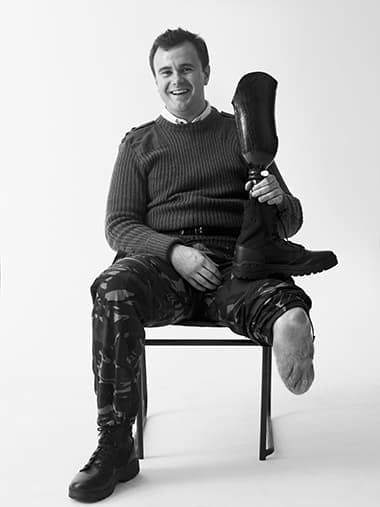Bryan Adams, who has sold many millions of records worldwide, turned his hand to professional photography in the late 1990s – having spent years taking pictures on tour as a musician. Today he launches a new book, Wounded – The Legacy of War, which features more than 100 ‘raw and unsettling’ images

Above: Bryan Adams
CC: What was the most rewarding aspect of this project for you?
BA: Two things; getting it going and getting it finished. This whole thing started out as a possible exhibition and now it’s a book. I’d still love to do an exhibition of these photos in the UK someday. I also love the title of the book ‘Wounded – The Legacy of War’
CC: How humbling an experience was it?
BA: Extremely humbling. Plus the amazing thing was many of these people had never revealed their injuries in public/never been in a photo studio. So quite a step to take with someone they didn’t know
CC: What was the most difficult aspect of taking these photos and the biggest challenge in achieving the portraits you wanted?
BA: The biggest challenge was organising the photo sessions, luckily most of the subjects we wanted said ‘yes’. As for getting the right portrait, sometimes I knew I had the right one within a frame or two, sometimes it wasn’t until I went through [a] session and found something interesting that I hadn’t noticed before
CC: Were the subjects more difficult to photograph than those featured in your previous book, Exposed? [the book features friends and colleagues from the worlds of entertainment, art and fashion]. It seems such a different type of project.
BA: It was very different. As I said they weren’t professional models or actors
CC: What camera kit did you use and how long did the project take?
BA: It’s taken about four years to do, and the kit I used was mostly a Canon EOS-1D and a Mamiya RZ
CC: What do you think is the secret of producing a good portrait photograph – how important was it to put these particular subjects at ease beforehand, for example?
BA: The combination of good subject and interesting setting. In this case I always showed the next subject how the work was coming along so they knew what was happening and what the look was
CC: On a general level, who is the photographer you most admire?
BA: Penn or Avedon, they were both so good at 10×8 photography. I worked with a 10×8 camera for a time and the photos were always very special. You could aim your medium format camera at the same time, at the same subject, and get a completely different feel. I wish there was a digital equivalent. It’s not about pixels, it’s about the lenses
CC: What appeals to you most as a professional photographer and how does it compare with your music career, in terms of the creative expression it allows you?
BA: It’s the teamwork I love, I’m very grateful to the camera assistants, hair, make-up, stylists, props people I have worked with over the years
CC: What is your favourite portrait – either yours or someone you admire?
BA: I love Penn’s flower photos, no one can touch them in terms of technical beauty
CC: What was your most difficult moment as a photographer?
BA: I always feel as a photographer, it’s your duty to be discreet about your subjects, even if they were hard to work with
CC: The most useful gadget/accessory in your camera bag?
BA: My carbon-legged tripod and tripod head made by Gitzo / Manfrotto (Gitzo GT3540LS)
CC: What is the best piece of advice you’ve been given?
BA: Just when you think you have got the frame, take 10 more
CC: And, do you have a top tip for an aspiring portrait photographer?
BA: The unguarded moments are sometimes the most interesting
CC: What camera did you shoot with mostly on tour in the early days, before you took up photography professionally?
BA: I had a Canon AE-1 in the early days and when that packed up, I bought a Rolleiflex which is the best camera ever made. Half of the images in my retrospective book Exposed were taken on that camera
CC: Are you able to tell us about any upcoming photography projects you are working on?
BA: The book is the biggest thing this year, next year I have exhibitions and hopefully lots of interesting shoots
Wounded: The Legacy of War is published by Steidl on 11 November, priced £50 (ISBN 9783869306773). For details visit www.steidl.de
Proceeds will go to charities BLESMA, Blind Veterans UK, Combat Stress, SSAFA and War Child.







